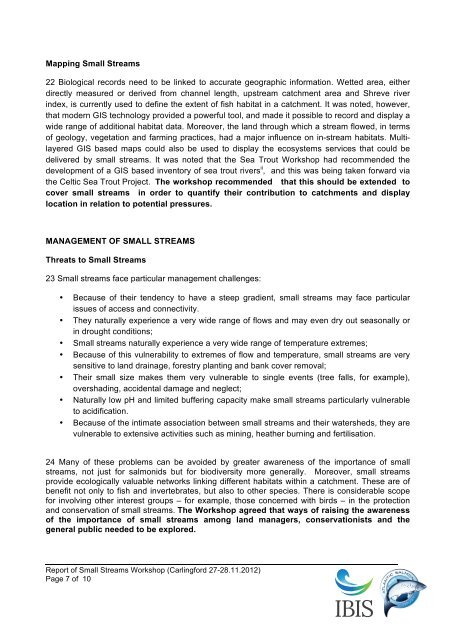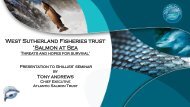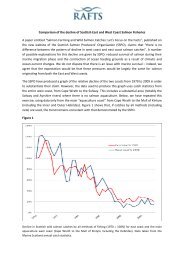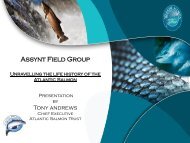small streams report final - The Atlantic Salmon Trust
small streams report final - The Atlantic Salmon Trust
small streams report final - The Atlantic Salmon Trust
Create successful ePaper yourself
Turn your PDF publications into a flip-book with our unique Google optimized e-Paper software.
Mapping Small Streams22 Biological records need to be linked to accurate geographic information. Wetted area, eitherdirectly measured or derived from channel length, upstream catchment area and Shreve riverindex, is currently used to define the extent of fish habitat in a catchment. It was noted, however,that modern GIS technology provided a powerful tool, and made it possible to record and display awide range of additional habitat data. Moreover, the land through which a stream flowed, in termsof geology, vegetation and farming practices, had a major influence on in-stream habitats. MultilayeredGIS based maps could also be used to display the ecosystems services that could bedelivered by <strong>small</strong> <strong>streams</strong>. It was noted that the Sea Trout Workshop had recommended thedevelopment of a GIS based inventory of sea trout rivers ii , and this was being taken forward viathe Celtic Sea Trout Project. <strong>The</strong> workshop recommended that this should be extended tocover <strong>small</strong> <strong>streams</strong> in order to quantify their contribution to catchments and displaylocation in relation to potential pressures.MANAGEMENT OF SMALL STREAMSThreats to Small Streams23 Small <strong>streams</strong> face particular management challenges:• Because of their tendency to have a steep gradient, <strong>small</strong> <strong>streams</strong> may face particularissues of access and connectivity.• <strong>The</strong>y naturally experience a very wide range of flows and may even dry out seasonally orin drought conditions;• Small <strong>streams</strong> naturally experience a very wide range of temperature extremes;• Because of this vulnerability to extremes of flow and temperature, <strong>small</strong> <strong>streams</strong> are verysensitive to land drainage, forestry planting and bank cover removal;• <strong>The</strong>ir <strong>small</strong> size makes them very vulnerable to single events (tree falls, for example),overshading, accidental damage and neglect;• Naturally low pH and limited buffering capacity make <strong>small</strong> <strong>streams</strong> particularly vulnerableto acidification.• Because of the intimate association between <strong>small</strong> <strong>streams</strong> and their watersheds, they arevulnerable to extensive activities such as mining, heather burning and fertilisation.24 Many of these problems can be avoided by greater awareness of the importance of <strong>small</strong><strong>streams</strong>, not just for salmonids but for biodiversity more generally. Moreover, <strong>small</strong> <strong>streams</strong>provide ecologically valuable networks linking different habitats within a catchment. <strong>The</strong>se are ofbenefit not only to fish and invertebrates, but also to other species. <strong>The</strong>re is considerable scopefor involving other interest groups – for example, those concerned with birds – in the protectionand conservation of <strong>small</strong> <strong>streams</strong>. <strong>The</strong> Workshop agreed that ways of raising the awarenessof the importance of <strong>small</strong> <strong>streams</strong> among land managers, conservationists and thegeneral public needed to be explored.Report of Small Streams Workshop (Carlingford 27-28.11.2012)Page 7 of 10





